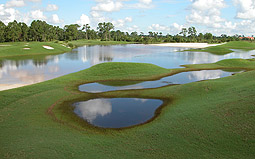The Aftermath of Fay
Tropical Storm Fay first made landfall in Key West, Florida on Sunday August 17 th , and then slowly meandered northward, and finally, after an entire week, exited the Panhandle of Florida. While this storm did not pack the damaging winds experienced with the hurricanes of 2004 and 2005, it was still a record setting weather event. With four separate landfalls, its slow movement northward up the east coast resulted in a massive quantity of water being dumped on the state. From Melbourne to Jacksonville, some locations received one to two feet of rain in a 24- to 36-hour stretch. There also were feeder bands that produced sustained rainfall of more than one inch per hour. This single storm event has ended a two year rainfall deficit that has plagued Florida.
Along the east coast, from just north of Palm Beach County and up to Jacksonville, severe localized flooding closed golf courses. It will take quite a while for the flood waters to recede so that recovery measures can be fully implemented, let alone acceptable overall course conditioning reestablished. Besides the cost incurred with storm recovery and cleanup, the loss of revenue is an additional financial hit at many facilities that were already affected by reduced play because of the struggling economy. Also, with the ground saturated and the drainage systems overloaded, subsequent afternoon thunderstorms, which are an inevitable fact of life, will exacerbate recovery efforts and increase the time required for getting courses re opened.
 |
Once the excess standing water has been removed, the next step is cleaning up and removing organic debris. Some restraint needs to be exercised with the use of heavy equipment potentially inflicting additional damage. Flood debris and removal tends to be a hand labor intensive and time consuming proposition. Once the debris clean up is accomplished and a reasonably firm surface exists, core aeration, deep slicing, or spiking operations need to be initiated to reestablish adequate soil oxygen content and to stimulate increased turf growth. If at all possible, two to four aeration replications on a once a week basis are encouraged.
With any extremely heavy rainfall event, leaching of nutrients out of the turf rootzone is another consequence. Thus, it is extremely important to reestablish adequate nutrient availability to support sustained and balanced overall growth. Given the possibility of heavy rainfall events still occurring over the next two to three months and the tremendous increase in the cost of fertilizers, a growing trend is the expansion of spoon feeding fertilization programs to include both tees and fairways. More frequent applications of lower rates of nutrients does not incur a significant additional cost, but additional time and labor is needed for this type of program.
 |
Finally, with just enduring a record setting rainfall event, a lot of people assume that supplemental irrigation is not necessary for at least several days. This simply is not the case, especially with putting greens. The combination of high sand content rootzone mixes with limited moisture retention and a shallow root system can result in the onset of drought stress in only a day or two when rain does not occur. Thus, while there still may be standing water in many areas throughout a golf course, resumption of routine putting green irrigation is required. If it is not possible to only irrigate the putting surfaces because of limitations in coverage patterns and control of the irrigation system, hand watering is advised to avoid exacerbating problems.
These are difficult times for many golf courses in Florida. Todd Lowe and I are both available to make Turf Advisory Service (TAS) visits to golf courses to assist with the recovery efforts. Call our Hobe Sound office at 772-546-2620 for additional information.
